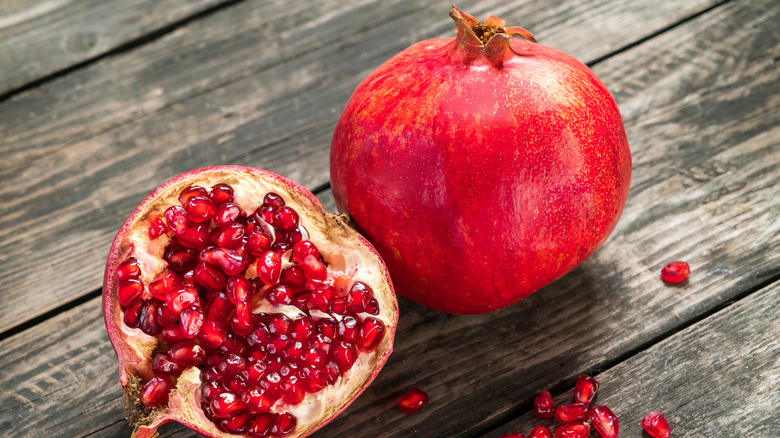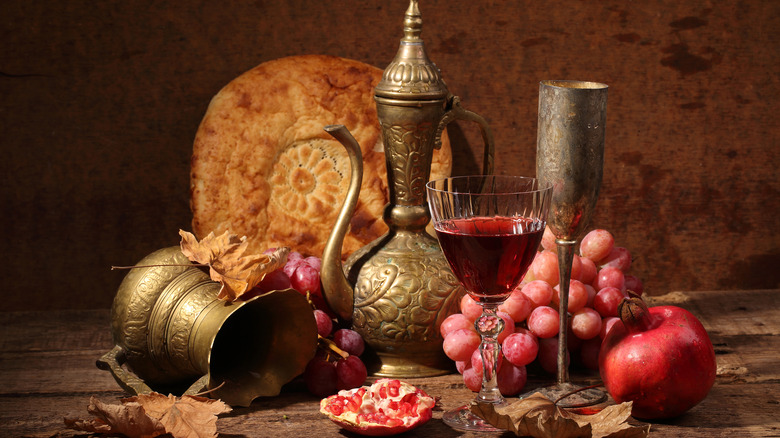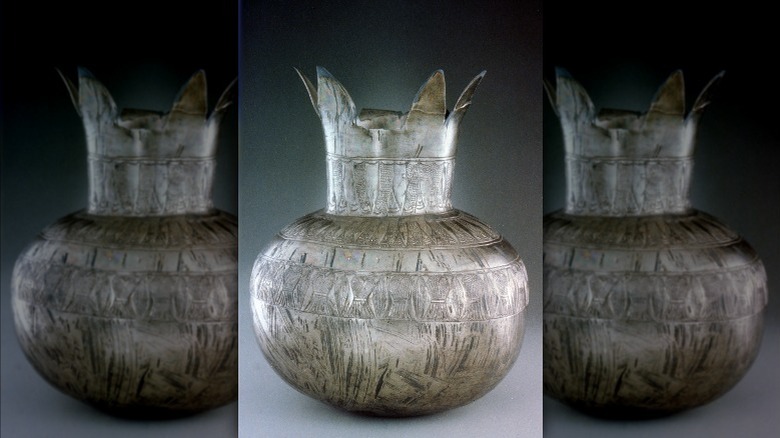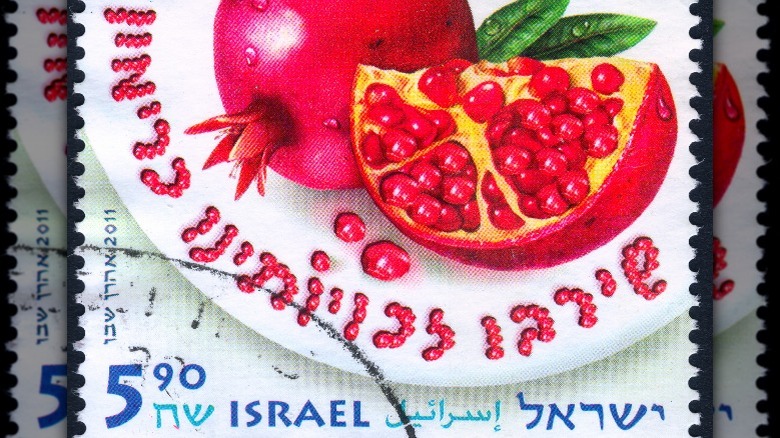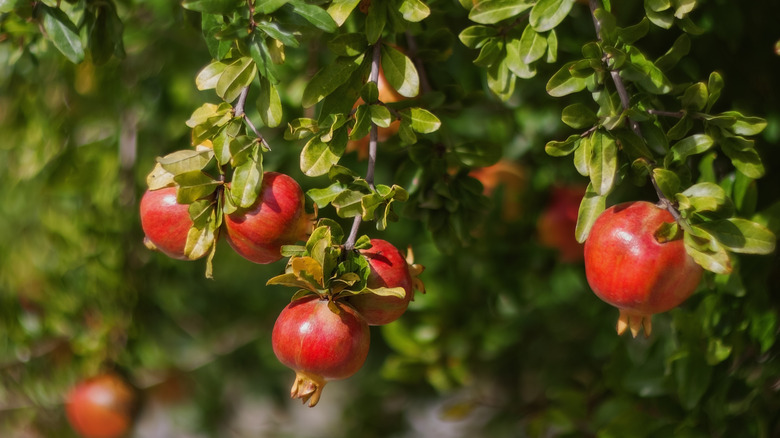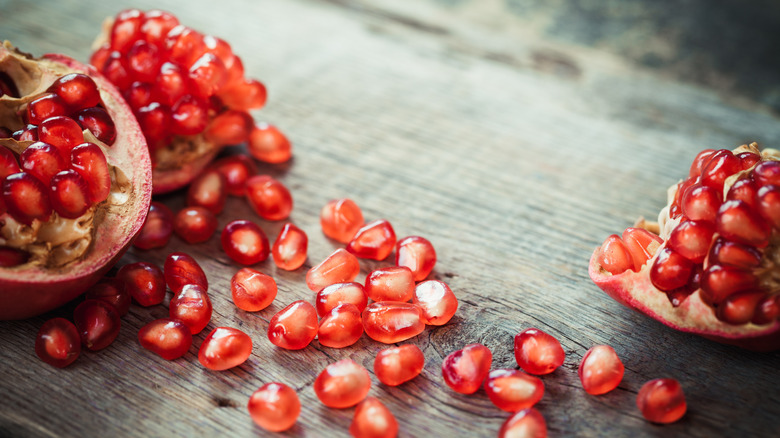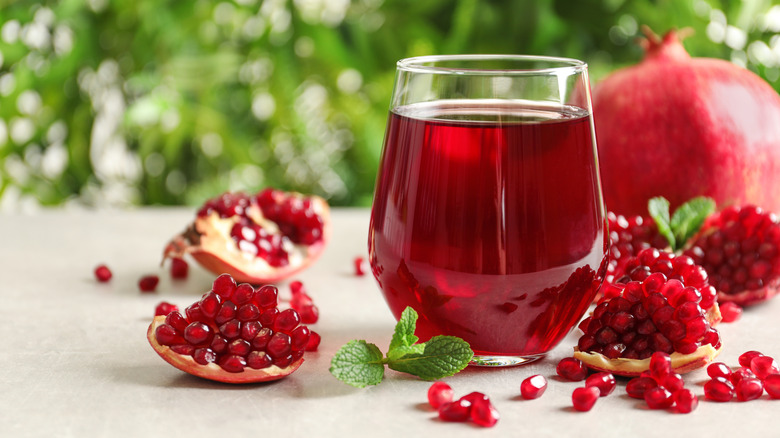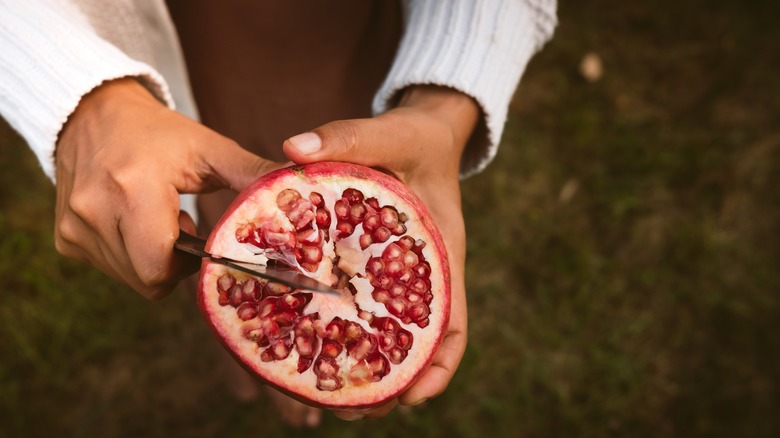From The Bronze Age To The American Table: A History Of The Pomegranate
We may receive a commission on purchases made from links.
The pomegranate tree (Punica granatum) originated in ancient Persia (current day Iran) as far back as the Bronze Age (5,000 B.C. – 3,000 B.C.). According to Missouri Botanic Garden, it is classified as a deciduous shrub, meaning its leaves will fade to yellow and fall off on a seasonal basis, generally topping at around 20 feet tall. It's a warm weather tree that particularly likes a hot and dry summer followed by a chilly winter. So, within the U.S., it's only winter hardy in USDA zones 8 through 11, and it's most likely to be found growing in states like California and Arizona.
Starting in April, pomegranate trees bear showy red flowers, many of which can self-pollinate, per New Mexico State University's College of Agriculture. Hummingbirds and bees take care of the rest of the pollination work, eventually forming the decadent pomegranate fruit known worldwide as a superfood. Ripening takes up to seven months, which is why pomegranates have a reputation as holiday crowd-pleasers.
Similar in size to a large orange, the fruit of the Punica granatum has a thick flesh that hides a multi-chambered interior with an abundance of gorgeous garnet arils, which are commonly referred to as the seeds. Botanically speaking, arils are sacs that surround each individual seed and contain the juice. Each piece of fruit contains around 600 delicious, ready-to-eat, nutrient-dense, edible arils or seeds. Get ready to work for them, though, because they don't simply fall out.
The first cultivated fruit
Cultivation of the pomegranate may predate the Bronze Age, but what archaeologists are sure of is that it was one of the first, if not the first, farmed and harvested fruit crops (via ResearchGate). For centuries pomegranates have been a common ingredient throughout Middle Eastern cuisine, reports Alimentarium, especially in Persian food, where it is called anār. You'll find them front and center in a classic fesenjoon, a walnut and duck stew.
In Turkey, pomegranate molasses adds a tangy kick to a popular sauce called muhammara, as well as a mixed salad called kisir. Throughout the Caspian region, pomegranate seeds show up in stuffings made for baked fish, while the juice is mixed into a meat stew called anār-āvīj.
Since its Latin name, Punica granatum, translates to seeded apple, the pomegranate is believed by many to have been the actual Forbidden Fruit referred to in the story of the Garden of Eden. According to Live Science, the confusion likely stemmed from a 382 A.D. request from Pope Damascus I to have the bible translated into Latin. Biblical scholar St. Jerome, used the word malum for the unspecified fruit because it also held the meaning of evil. Malus, a variation of the same word, is the Latin genus name of the apple tree. It was painters who placed an apple in Eve's hand. The original story only mentions a generic seeded fruit, so they had to pick something, and Malus domestica won out.
Pomegranates in ancient Egypt
These days we don't think much about traveling a few thousand miles, but for fruit to make it to a new continent in ancient times, we know the folks who brought it with them undertook quite a journey. Historians suspect pomegranates made their way from Syria and into Egypt as early as 1600 B.C., when the Hyksos dynasty from Palestine ruled the land throughout the Middle Kingdom (via ResearchGate).
According to Middle East Eye, a pomegranate-shaped vase was discovered in the tomb of Tutankhamun, also known as King Tut, suggesting the pharaoh who ruled during the 14th century B.C. wished to have one with him in the afterlife. Alongside other vessels and artworks in the image of the fruit, archaeologists have also found specimens of dried fruit. Furthermore, the pomegranate tree is mentioned in ritual texts and ancient poems. The oldest intact piece of fruit was found in the tomb of Djehuty, having been placed there during the New Kingdom (c. 1570-1069 B.C.).
Pomegranates were commonplace in the royal palaces; Food Reference explains that, back then, the ancient Egyptians were already using pomegranate juice to help soothe gastrointestinal distress and cure issues with tapeworms. They also crushed flower petals and fruit peels into dyes.
Pomegranates in ancient Israel
Throughout many of the world's most prominent religions, the pomegranate has been used to represent life, death, wealth, and fertility; Judaism is no different. According to the Jewish Food Experience, the Torah is peppered with mentions of the beloved fruit. In the book of Deuteronomy, Moses reassured desert-bound Israelites that they would again experience the thirst-quenching juice of the pomegranate once they reached the Promised Land.
Pomegranates are included in the Seven Species of Israel alongside wheat, barley, grapes, figs, olives, and dates. Because the Land of Israel is the only place in the world where all seven crops naturally grow together, they're considered to have a special connection with the land (via Chabad.org). The original rabbinic story of the mitzvot, the Torah's version of commandments, cites individual pomegranate seeds as symbolic of each edict. It's almost accurate since each piece of fruit contains roughly 600 seeds, and there are 613 mitzvot. However, as explained by Jewish Action Magazine, it's a misconception that the historical text implies every pomegranate had exactly 613 seeds. Specifically, within Judaism, the fruit is a symbol of righteousness because all practicing Jews are duty-bound to fulfill the mitzvot.
Food52 says pomegranates are traditionally eaten on Rosh Hashanah with no restrictions on how they are used. Leah Koenig, author of "The Little Book of Jewish Feasts," saves them for dessert. Others suggest a glaze over challah bread, a braise for meats, or even pressed juice mulled into wine.
Pomegranates in ancient Greece
Many Greek myths mention the pomegranate, including its origins springing from the blood of a dying Adonis. However, there's one myth you should know before ingesting a handful of seeds; the tale of Persephone. As the story goes, Persephone is kidnapped by Hades, ruler of the underworld, who promptly falls in love with her (via The Delphi Guide). Persephone's mother, Demeter, goddess of the harvest, went into mourning, forcing the earth to fall fallow for months, not allowing any plant to bear fruit.
When she finally located her daughter, Demeter struck a deal with Hades that allowed Persephone to live with her for two-thirds of the year (spring, summer, fall) and in the underworld for the remaining time (winter). Before he let her go, Hades convinced Persephone to eat pomegranate seeds, the fruit of her captor, as a promise to return at the designated time.
Per the Greek Reporter, ancient Greeks smashed a pomegranate on New Year's Day to symbolize good fortune and abundance, likely due to the sheer volume of bright red seeds that would pour forth, glistening like garnet and ruby gemstones. Famous Greeks who revered the pomegranate include Homer, who featured the fruit in his epic poem The Odyssey, and Hippocrates, the father of modern medicine himself. Hippocrates expanded upon ancient Egypt's medicinal discoveries and prescribed its extract to reduce skin inflammation and more inflammation (via the American Society for Horticultural Science).
Pomegranates arrive in America
It is generally accepted amongst horticulturists that the pomegranate arrived in America via Spanish conquistadors in the 16th century. Jesuit missionaries likely brought the fruit and tree cuttings to their settlements in California before traveling east through Texas and eventually to St. Augustine in Florida, says Texas A&M University's Cooperative Extension. By 1772 pomegranates were growing wild in Georgia (via Madera Chamber of Commerce Tourism Alliance). Since then, pomegranate trees have managed to naturalize themselves, meaning they reproduce on their own with no need of assistance from human growers.
The only problem is that Americans have experienced just one kind of pomegranate, a varietal called 'Wonderful,' simply because it was the first to arrive and be cultivated (via Discover Magazine). Most of us wouldn't even know there are other varieties to choose from, so we take what we can get. A genetic scientist in California named John Chater is doing his best to change that, which could go a long way in broadening our flavor palate and creating more versatile recipes.
As reported by Discover Magazine, the fruits of other countries, such as Iran and India, tend to be sweeter with softer seeds and an array of colors, including pinks and yellows. Chater believes these other varieties deserve a chance. He's working with fruit breeders to create sweeter tasting options than the 'Wonderful' to produce a fruit that's also pest and disease-resistant.
Nutritional value and health benefits of pomegranates
The world's oldest cultivated fruit is also one of the healthiest, with a long list of benefits that go far beyond its burst of tart flavor. If you're wondering what happens to your body when you eat pomegranate seeds, the answers are mostly very positive because of its high nutritional value and purported health boosters.
Healthline reports that the seeds of an average-sized pomegranate contain 11 grams of fiber, almost 5 grams of protein, and 3 grams of healthy fats. They also provide 27% of the daily recommended intake of folate (vitamin B9) and 32% for vitamin C. Juicing the seeds will rob them of much of their fiber content and reduce their level of vitamin C. However, the juice remains nutritious and is associated with heart health. This powerhouse produce is also thought to help lower blood pressure and reduce inflammation.
From antioxidants that protect cells against free radicals to antimicrobial properties to compounds shown to fight cancer, it seems like there's nothing this fruit can't do. These nutritional and health benefits combine into a solid defense on why you should be eating more pomegranates but note that they're not 100% accurate. We can deduce that wellness-minded humans have been using the fruit for thousands of years, but, as CNN reported in 2010, that doesn't mean there's much truth behind a major brand's claims that drinking their juice reduces arterial plaque by 30%.
Pomegranates on the American table
Americans love ourselves a superfood, and chefs have been adding this one to dishes for years. Sometimes it's a straightforward application, like in this squash and pomegranate salad recipe with fresh seeds sprinkled on top. Other times, the flavor profile takes a backseat as a base layer.
For savory dishes, pomegranate molasses is a go-to ingredient for home-based epicureans and professional chefs. Start with fresh seeds pulverized in a food processor and strained, or simply purchase a bottle of 100% pure juice at the market. From there, the recipe is simple. Boil down 8 cups of juice with a tablespoon of salt and the juice of one lime. Simmer for around an hour. Ultimately, the mixture should become a thick syrup that reduces to about 2 cups.
Similar to a balsamic reduction, pomegranate molasses has a more intense tang with nearly limitless potential as a marinade or glaze for either meats or vegetables. It is found in most Middle Eastern recipes but transfers equally well to barbecues and roasted dishes. If you're feeling particularly experimental, try something different and drizzle the molasses over vanilla ice cream for dessert.
One of the best things about pomegranates ripening late in the year is they give us a tangy fruit option for winter. Just because it's cold outside doesn't mean you're never in the mood for something like this pomegranate curd tart. Extra filling can be served over fruit or blended into a smoothie later.
Pomegranate beverages
Except for the loss of fiber and a slight reduction in vitamin C, all of the same nutritional and medicinal benefits apply to pomegranate juice as to the arils (seeds) in their whole fruit form. Keeping in mind that no single food or beverage can solve all of our health issues with a snap of the fingers or a swallow of magic elixir, pomegranate juice remains a highly regarded addition to a well-thought-out and balanced diet. The key, per CNN, is to stick to juices with zero added sugar and keep serving sizes to 8 ounces.
Ina Garten mixes pomegranate juice with Pellegrino and lime juice for a simple, refreshing non-alcoholic spritzer. Mixologists have also gotten in on the pomegranate game. In fact, as noted by Taste Atlas, the word for grenadine comes from grenade, the French word for pomegranate. Sadly, modern day grenadine is primarily made from high fructose corn syrup and has little to no resemblance to the original, which was thought to have had a pomegranate base.
This Jack Rose cocktail recipe calls for pomegranate juice mixed with simple syrup to create grenadine for an applejack cocktail. Another fun cocktail is this cucumber pomegranate margarita, which brings the familiar salad companions together in beverage form.
How to cut and deseed a pomegranate
After all this talk about the stunning flavor and outrageous nutritional value, you're probably ready to load up on pomegranates. Once you get your haul home, figuring out just how to get them open can be perplexing. One popular option is to slice across the top to remove the stem, then cut downwards along each ridge to remove a section. Simple enough, but now that you've got it open, how the heck do you deseed this thing?
Though it seems unlikely at the start, with a little practice, removing pomegranate seeds is possible without making a mess. There are three basic methods to try. For those with plenty of time to spare, you can sit quietly with your pomegranate, individually picking out each seed as you contemplate the more philosophical elements of life. For those who really can't stand to risk getting anything stained by the ruby red juice, place your sliced pieces in a bowl of water and remove them while submerged.
Finally, for anyone who just needs to get this task done already, the quickest way to hack your pomegranate seeds is to slice the fruit into two equal-sized pieces, hold one half over a bowl with the sliced side in your palm, and the remaining rind facing up. Now whack it with the back of a wooden spoon and allow the loosened seeds to fall through your fingers down into the bowl.
Pomegranates in skin care
Pomegranate seed extract boasts a highly valuable combination of fatty acids, polyphenols, and antioxidants, so it should be no surprise that these properties have been harnessed into natural cosmetics and cleansers within the skin care industry. Pomegranate seed extracts and oils are touted to keep skin healthy and youthful by combatting common signs of growing older such as fine lines, wrinkles, and age spots.
In addition, the seeds are highly regarded for their ability to regenerate cells on both the outer (epidermis) and inner (dermis) layers of the skin, according to the beauty editors at Byrdie. They further explain that pomegranate seed oil has a polyphenol that hinders the growth of cancerous tumors, particularly those related to the skin, reducing incidents of acne, scarring, and cracked dry spots. Per Mind Body Green, the fruit's skin is also used to make oil. If you find an essential pomegranate oil on the market, be sure to mix it with a carrier oil such as jojoba, almond, or avocado; essential oils should never be applied directly to the skin.
You'll find pomegranate elements at the drugstore in everything from daily moisturizers to antioxidant face masks. Livestrong adds that the high vitamin C content of the fruit improves collagen synthesis while also helping the skin retain moisture.
